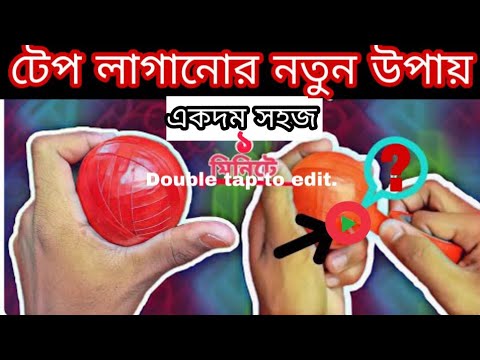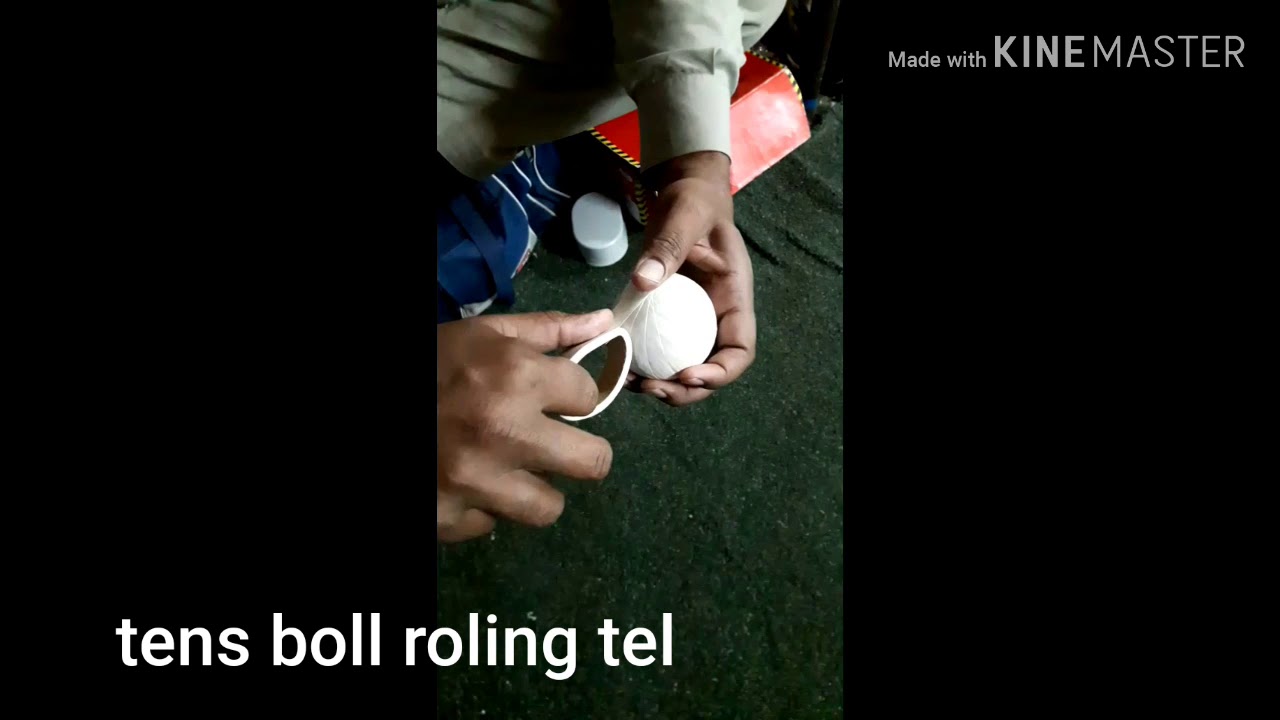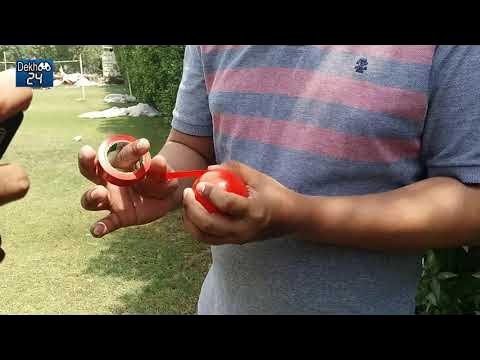Are you looking to spice up your cricket practice sessions? Taping a tennis ball could be your answer! This simple technique transforms a regular tennis ball into a lightweight, versatile tool that mimics the behavior of a cricket ball. Whether you’re a beginner mastering your bowling or an experienced player working on your fielding skills, a taped tennis ball can elevate your game without needing to hit the pitch. Let's explore how to tape a tennis ball effectively and why it’s such a beneficial practice tool.
Benefits of Using a Taped Tennis Ball in Cricket

Using a taped tennis ball in cricket might seem unconventional, but the benefits it offers can enhance your training in several ways:
- Improved Bowling Technique: The added weight and texture of a taped tennis ball can help bowlers focus on their bowling action, allowing them to practice different types of deliveries without the fear of injury associated with hard cricket balls.
- Enhanced Fielding Skills: The unique bounce of a taped tennis ball can simulate various ground conditions, helping players develop quick reflexes and better catching techniques. Players will learn to adjust their body positions and anticipate ball movement effectively.
- Cost-Effective Training: Cricket equipment can be expensive, especially for beginners. Taping a tennis ball is a low-cost alternative that provides a safe way to practice without needing a full cricket infrastructure.
- Safe for Indoor Practice: If you're restricted by space or weather, practicing with a taped tennis ball indoors ensures you won’t damage your surroundings or injure anyone. The soft nature of the ball coupled with the tape makes it safe for use in tighter spaces.
- Focus on Technique: Taped tennis balls allow players to concentrate on their footwork, timing, and shot selection without the distractions of playing with a standard cricket ball. This focus can lead to improved on-field performances.
When taping a tennis ball, it’s important to ensure an even layer of tape to maintain its balance and integrity. You can choose different colors or types of tape to help with visibility or grip. Experiment with the number of layers to get the desired weight and bounce according to your needs.
Incorporating a taped tennis ball into your cricket training routine can dramatically improve your skills while keeping things fun and creative. So grab a tennis ball, some tape, and get ready to elevate your game in more ways than one!
Also Read This: How to Make a French Tail Step by Step on Dailymotion
3. Materials Needed for Taping a Tennis Ball

Before you dive into the process of taping a tennis ball for cricket, it’s essential to gather all the necessary materials. Having everything on hand will make the process smoother and help you achieve the best results. Let’s take a look at what you’ll need:
- Tennis Ball: This is obviously the star of the show! Choose a ball that is in good condition, as it will affect your gameplay.
- Electrical Tape or Duct Tape: The type of tape you choose is important. Electrical tape is flexible and easy to work with, while duct tape offers durability. Choose the one that suits your needs best.
- Scissors: A good pair of scissors will help you cut the tape to the desired lengths.
- Ruler or Measuring Tape: This isn’t mandatory, but using a ruler can help you measure the tape sections accurately if you want uniformity in your taping style.
- Marker (optional): If you want to mark specific spots on the ball for taping, a marker can come in handy.
Once you've gathered these materials, you're ready to start the exciting part—actually taping the ball!
Also Read This: Play Dailymotion Videos on iPad with Simple Tutorials
4. Step-by-Step Guide to Taping a Tennis Ball

Taping a tennis ball for cricket might sound like a simple task, but doing it correctly can make a significant difference to your play. Follow these step-by-step instructions to properly tape your tennis ball:
- Choose Your Design: Before you start taping, think about how you want the ball to look when it’s done. Some prefer a completely wrapped look, while others might want just a few strategic strips.
- Prepare the Ball: Ensure your tennis ball is clean and dry. If it's a bit dirty from outdoor play, give it a quick wipe with a cloth. A clean surface will help the tape stick better.
- Cut Your Tape: Depending on your desired design, cut the tape into strips of various lengths. A common width to aim for is about 1 inch. Factor in how many different colored layers or sections you want as well.
- Start Taping: Begin by applying the tape at the seam of the ball. Secure one end of the tape firmly and then wrap it around the ball, following the contours. Overlap the tape slightly as you wrap to ensure complete coverage without gaps.
- Continue Wrapping: If you aim to cover the entire ball, keep wrapping until you reach the other end. If you prefer a more artistic approach with patterns or stripes, alternate colors and thicknesses as desired.
- Secure the Ends: Once you’re satisfied with the amount of tape, trim any excess. Make sure all ends are securely pressed down to avoid peeling during play.
- Test the Ball: Now that you’ve completed taping, give the ball a good throw or hit. This will help you check if everything is secure and allows you to adjust if needed!
And there you have it! A beautifully taped tennis ball ready for some spirited cricket action. Grab your friends, head to the field, and let the games begin. Don't forget to check out the Dailymotion video guide for a visual walkthrough of the process—it can be super helpful if you're a visual learner!
Also Read This: How to Make a Princess Cake with a Step-by-Step Dailymotion Tutorial
5. Instructions for Creating an Effective Ball Tape
Taping a tennis ball to use it for cricket practice can be a game-changer, boosting your skills without needing proper equipment. But getting it right is essential! Follow these simple steps for creating an effective ball tape:
- Gather Your Materials: First things first, make sure you have everything on hand:
- A tennis ball
- High-quality adhesive tape or electrical tape
- Scissors
- A flat surface to work on
- Prepare the Tennis Ball: Inspect the tennis ball for any damage. If it’s too worn out, consider using a different one for the best results.
- Start Taping from the Top: Begin at the top of the tennis ball. Wrap the tape around the ball, ensuring that you cover it adequately for stability. Overlap the tape slightly as you go to create a sturdy layer.
- Cover the Entire Surface: Continue wrapping the tape around the ball, gradually moving down. Your goal is to ensure the entire surface is covered, but leave the bottom third of the ball free to allow for a natural bounce and grip when you hit it.
- Secure the End: Once you’ve wrapped enough tape, cut it with scissors and press firmly on the end to ensure it sticks well. You don’t want the tape to peel off during practice!
- Test It Out: Before you dive into your practice session, throw the ball a few times to check its durability. It should feel manageable and easy to grip.
By following these steps, you can create a reliable and effective ball tape that will enhance your practice sessions. Don’t forget to check the tape after a few uses to see if it needs a refresh. Happy practicing!
Also Read This: Using IDM to Download Videos from Dailymotion
6. Common Mistakes to Avoid When Taping a Tennis Ball
Even with the best intentions, it’s easy to make mistakes when taping a tennis ball for cricket. Here are some common pitfalls to watch out for:
- Using Poor Quality Tape: Not all tape is created equal! Using low-quality tape can lead to premature peeling or breakage. Stick with strong, durable tape like electrical or duct tape.
- Insufficient Coverage: Leaving large areas of the tennis ball uncovered can affect your control and the ball's movement during practice. Ensure you cover enough of the ball for a good balance between weight and bounce.
- Too Much Tape: While you want adequate coverage, applying too much tape can make the ball overly heavy and difficult to handle. Find a balance that works for your needs!
- Not Testing the Ball: After taping, some people dive right into practice without testing the ball first. Always throw the ball a few times to make sure it performs as expected.
- Neglecting Maintenance: Taped tennis balls require upkeep. Regularly check for any wear and tear. If the tape starts to peel or tear, reapply it to keep the ball in prime condition.
Avoiding these common mistakes can make a big difference in your practice experience and lead to improved cricket skills. With a well-taped tennis ball, you can easily enhance your technique and learning. Happy cricketing!
Also Read This: How to Make a Paper Car That Moves: Fun DIY Project on Dailymotion
7. How to Use Your Taped Tennis Ball in Cricket Matches
Once you've mastered the art of taping a tennis ball, it’s time to put your creation to good use! Using a taped tennis ball in cricket can elevate your game, enabling you to practice various skills in a fun and innovative way. Here are some tips on how to effectively use your taped tennis ball during cricket matches:
- Bowling Practice: The taped tennis ball simulates a cricket ball well, allowing bowlers to practice spin, swing, and pace. The added weight from the tape can enhance your bowling technique.
- Batting Skills: Whether you’re working on your footwork or refining your shot selection, hitting a taped tennis ball can help improve your reflexes and timing.
- Fielding Drills: Improve your catching and ground fielding skills. The unpredictable bounce of the taped tennis ball can add a level of challenge that will prepare you for real match situations.
- Warm-Up Sessions: Use your taped tennis ball during warm-ups to get you in the zone before games. It’s a great way to loosen up your muscles and get a feel for the ball.
To get the most out of your taped tennis ball, consider setting up drills. For example, bowlers can practice their lines and lengths while batsmen can work on their defense against slower or faster deliveries. Fielders can use the ball to practice slip catching or throwing accuracy.
Keep in mind that while the taped tennis ball is an excellent tool for practice, be cautious when using it in an actual match. Ensure that all players are on board with the change and that the playing conditions are safe enough to prevent any injuries. Using this ball can add an element of fun to informal matches, so don't hesitate to introduce it during casual games with friends or family.
Also Read This: How to Fix Issues When You Can’t Watch Dailymotion Videos on Your Device
8. Watch Related Tutorials on Dailymotion
If you're looking for more visual guidance on using a taped tennis ball for cricket, Dailymotion is a fantastic resource! Here’s a quick guide on what you can find:
- Tutorials on Taping Techniques: Watch step-by-step guides on how to effectively tape your tennis ball for optimal performance.
- Bowling Drills: Explore tutorials that showcase various bowling drills using the taped tennis ball to enhance your skills.
- Batting Tips: Find videos that offer tips on how to handle different types of deliveries when using a taped ball.
- Game Play Videos: Check out recordings of real matches played with taped tennis balls to see how players adapt their strategies.
Viewing these tutorials can provide you with unique insights and allow you to learn from others' experiences. Plus, seeing the ball in action will help you understand its behavior differently compared to a standard cricket ball. To find these resources, simply search for relevant terms on Dailymotion, such as “taped tennis ball cricket” or “cricket tutorials.”
Incorporating visual learning into your training routine can make a significant difference. By watching skilled players and coaches demonstrating techniques and strategies, you’ll gain a deeper comprehension of how to effectively integrate your taped tennis ball into your cricket practice. So grab your device and check out those tutorials; they might just give you the edge you need to up your game!
Conclusion and Tips for Best Practices
Taping a tennis ball for cricket can be a fun and effective way to practice your skills. With the right technique, you can create a ball that simulates the motion of a real cricket ball, allowing for more realistic training sessions. Here are some best practices to ensure you get the most out of your taped tennis ball:
- Quality Tape: Choose a durable tape that will hold up during play. Duct tape is commonly used due to its strength and ability to conform to the ball's shape.
- Even Layering: Apply tape in an even layer to avoid creating any gaps or excess weight that can affect ball performance.
- Maintain Balance: Ensure your tape job is symmetrical to maintain balance, which is crucial for achieving realistic flight and bounce.
- Test Before Use: Always test the taped ball before using it in practice. Check how it behaves under different bowling styles.
- Safety First: Use protective gear, such as a helmet and pads, when practicing with a taped tennis ball, especially if you're bowling fast.
Additionally, watching tutorials or guides, such as those on Dailymotion, can provide visual aids to help you through the taping process more effectively.
In conclusion, by following these tips and utilizing video resources, you can maximize your training efforts with a taped tennis ball, enhancing your cricket experience while having fun in the process.
 admin
admin








